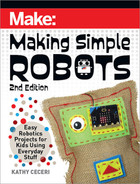
TROUBLESHOOTING
FOR SUCCESS
Preface
Cover Page “i”
Preface Intro Chap 1
Xxxxxx Chap 3
Chap 3 Chap 5 Chapter 2
viii
Making Simple Robots, 2nd Edition
Make_Simple_Robots_interior_FIN.indd 8Make_Simple_Robots_interior_FIN.indd 8 4/26/22 1:53 PM4/26/22 1:53 PM

In this book, I introduce you to the most valuable skill a robot builder (or
any kind of inventor) can have.
It isn’t knowing how to work with power tools, soldering irons, or laser
cutters. Those skills are useful when you’re building more complicated
robots – but you won’t need them to make any of the robots in this book.
And it’s not being able to write computer programs, or create 2D and 3D art
— although you’ll get to do both as you try out the projects in these pages.
So what’s the super-important skill every robot-maker needs?
It’s knowing how to troubleshoot!
Troubleshooting is a way to figure out why your project isn’t working and
how to fix it. It means:
• Going back through each step you followed, one by one.
• Looking for clues that could point to what went wrong.
• Coming up with ideas that might fix the problem.
• Keep trying different ideas until you find the right one.
Troubleshooting is the reason why people like engineers, programmers,
designers, and artists don’t just give up and walk away as soon as things go
ka-blooey.
It’s how anyone can take a failure and – with a little luck – turn it into a
success. (A lot of the time, at least.)
If that sounds tough, it is! Learning how to troubleshoot can be hard for
beginners, especially if you’ve never tried to fix anything yourself before.
Just like any new skill, it takes practice to get good at it.
Cover Page “i”
Preface Intro Chap 1
Xxxxxx Chap 3
Chap 3 Chap 5 Chapter 2
Preface ix
Make_Simple_Robots_interior_FIN.indd 9Make_Simple_Robots_interior_FIN.indd 9 4/26/22 1:53 PM4/26/22 1:53 PM

It might help to think about a time when you didn’t know how to do
something that’s really easy now, like writing your name, or riding a bike.
Maybe you figured it out quickly. But chances are, you needed a little help
and encouragement to get started. And the more you practiced, the better
you got. Doing it over and over helped you build up the muscles in your
hand that let you hold a pen straight, or the muscles in your legs that help
you pump the pedals.
When you practice troubleshooting, you build up your persistence muscles.
They help you stop feeling frustrated and keep going, until you figure out
whether or not your problem can be solved.
Of course, not every idea works out. Sometimes even the best robot-
builders have to give up and try something else. The family behind Beatty
Robotics, Camille and Genevieve Beatty and their dad Robert (an engineer
and author of the best-selling Serafina adventure series), began fooling
around with robot kits when the sisters were only 9 and 11. They quickly
filled a container with burned-up electronics and broken tool bits that they
jokingly called the “Box of Shame.” But they didn’t let their failures slow
them down. With every project, they learned a little bit more and got a
little bit better. And just a couple of years later, they were building working
models of space rovers for science museums all around the world.
How can you learn to be persistent, like the Beatty family? Here are some
tips that may help you push through the tough spots:
• Give yourself plenty of time to figure out any steps that may give you
trouble.
• Get extra supplies, in case something breaks or is defective.
• Keep an eye out for inspiring people and projects at places like robot
competitions, science festivals, museums, and Maker Faires.
• To improve your skills, look for classes, camps, or clubs where teachers
and other experts can guide you as you work.
• Check out websites like Make.co, Instructables.com, and
ScienceBuddies.org, and books like the one you’re reading now to get
Cover Page “i”
Preface Intro Chap 1
Xxxxxx Chap 3
Chap 3 Chap 5 Chapter 2
x
Making Simple Robots, 2nd Edition
Make_Simple_Robots_interior_FIN.indd 10Make_Simple_Robots_interior_FIN.indd 10 4/26/22 1:53 PM4/26/22 1:53 PM

ideas and possible answers to problems you can’t figure out.
• Share the skills you develop with other people. Teaching is a great way
to learn new things yourself!
• Finally, think about creating your own “box of shame.” It may come in
handy when you need a spare part. And it will remind you how far you’ve
come when you troubleshoot your way to a successful project!
Good luck! If you have questions, comments, or suggestions about this
book, feel free to contact me. I’d love to hear about your adventures making
simple robots!
Kathy Ceceri
kathyceceri.com
Preface xi
Make_Simple_Robots_interior_FIN.indd 11Make_Simple_Robots_interior_FIN.indd 11 4/26/22 1:53 PM4/26/22 1:53 PM
..................Content has been hidden....................
You can't read the all page of ebook, please click here login for view all page.
